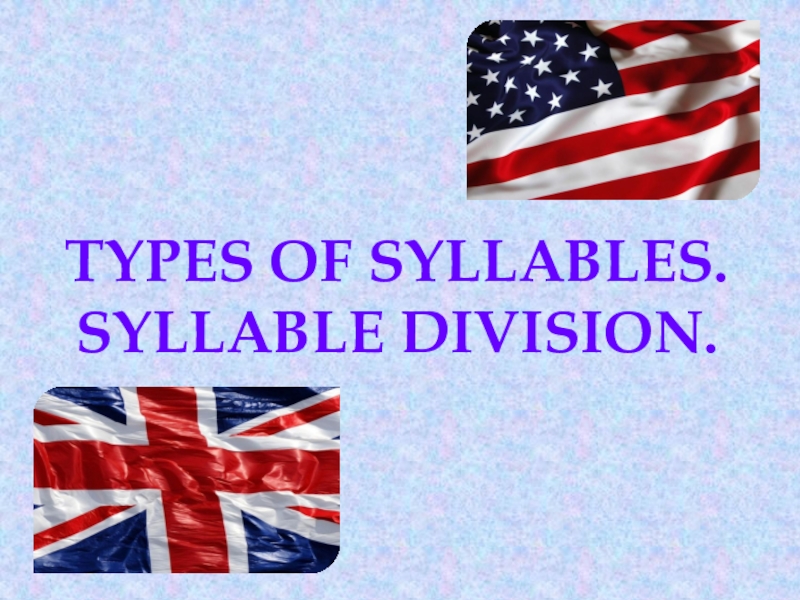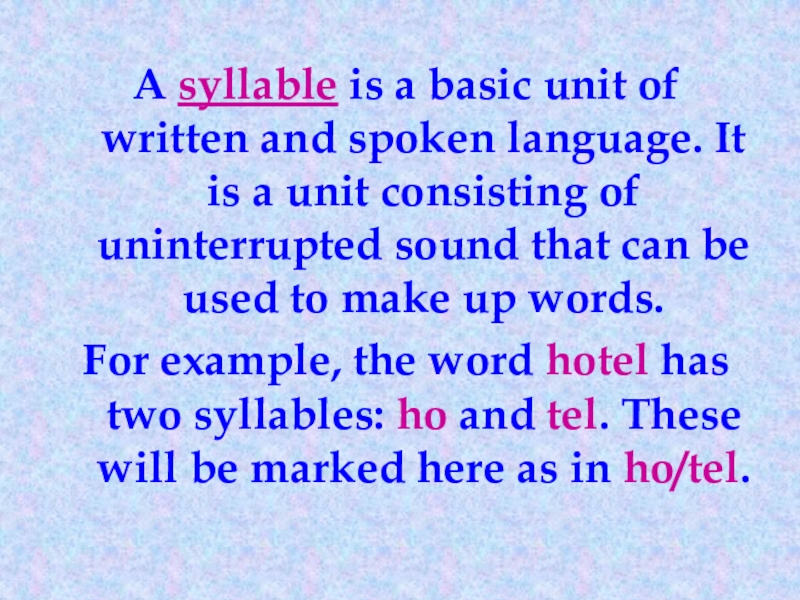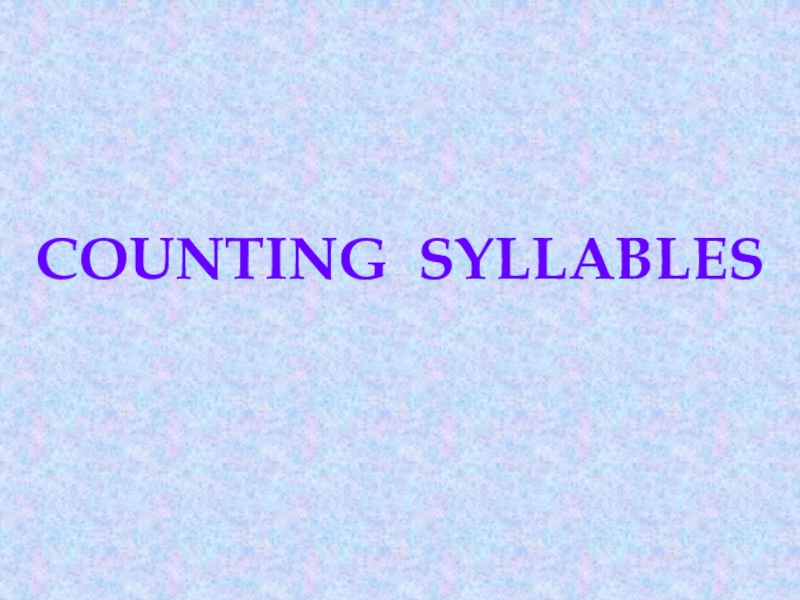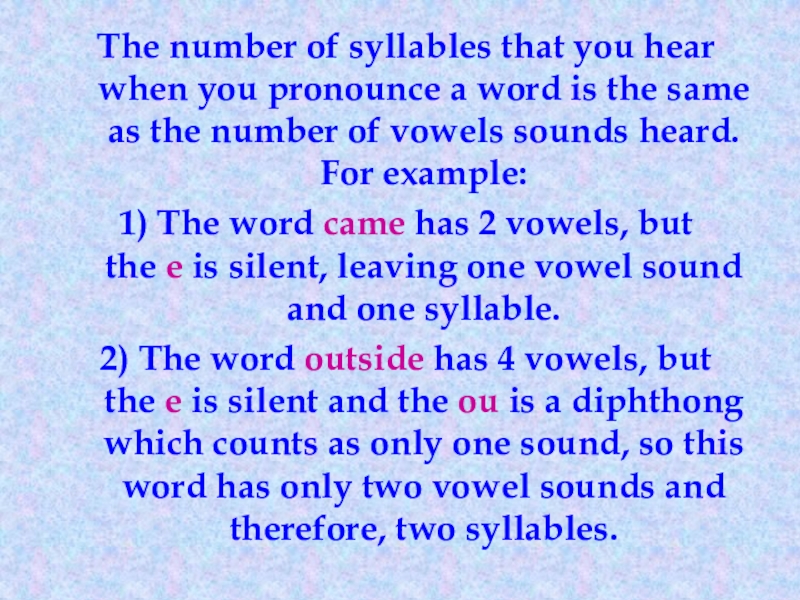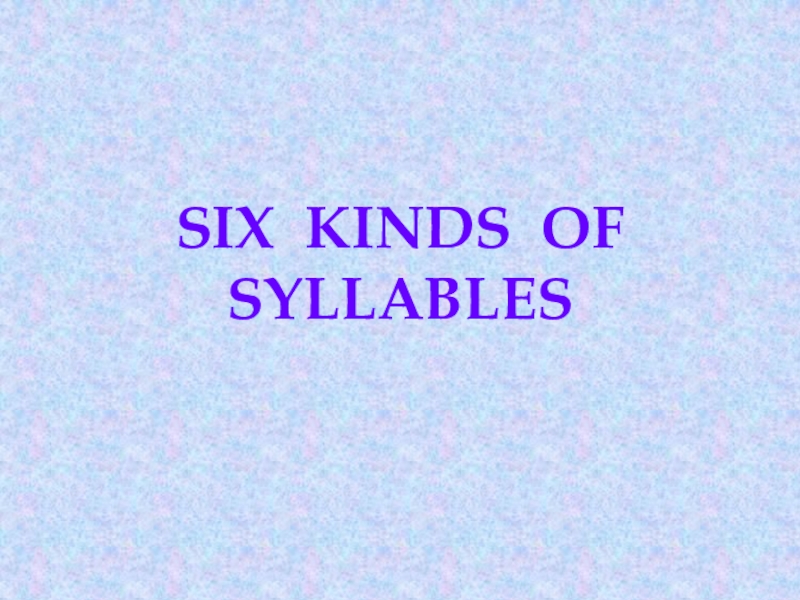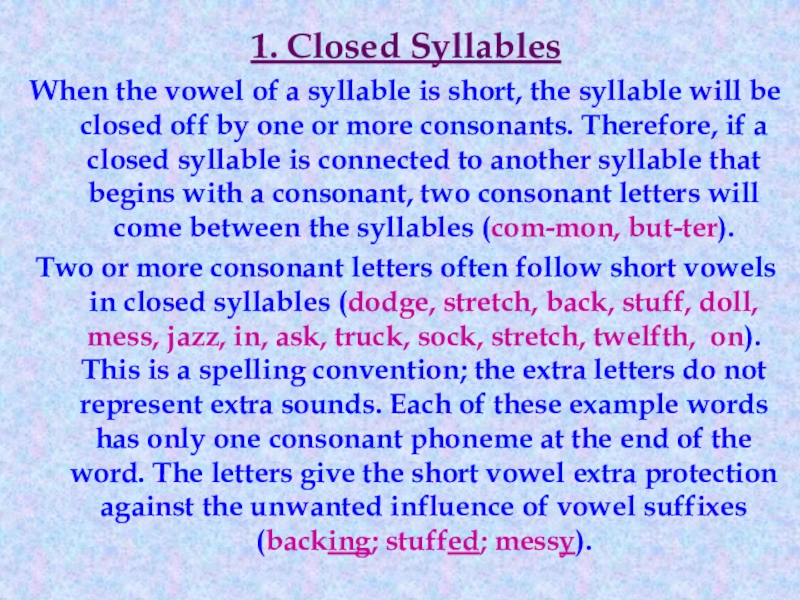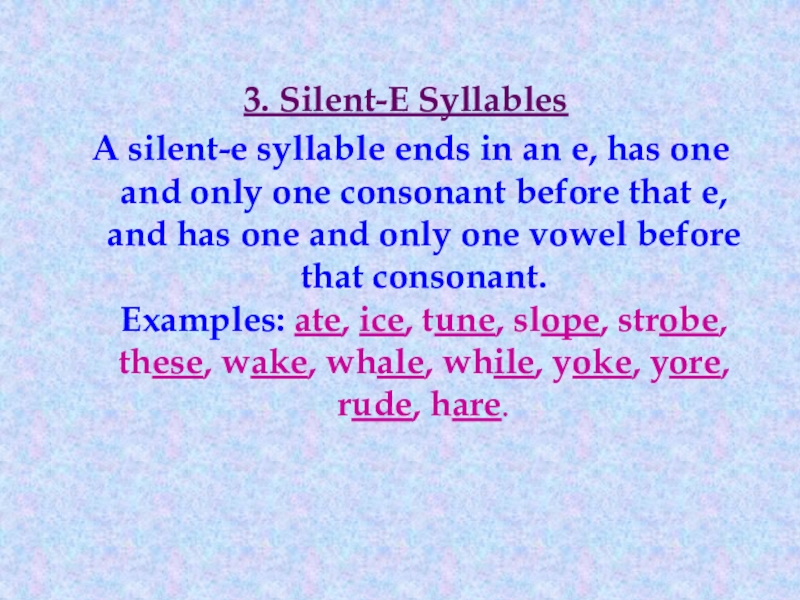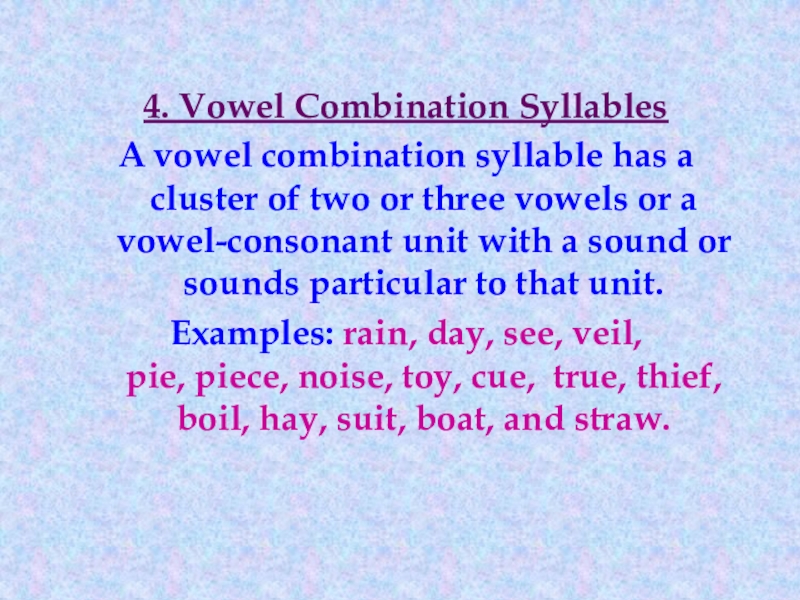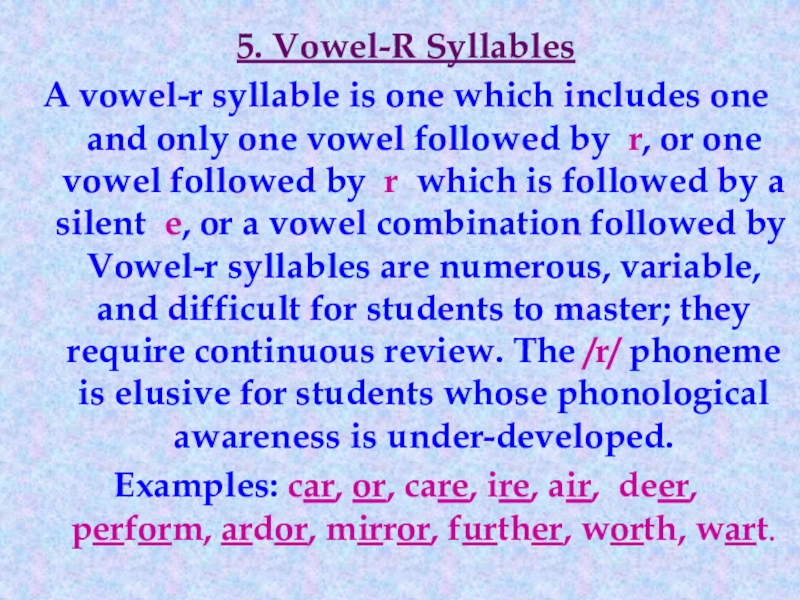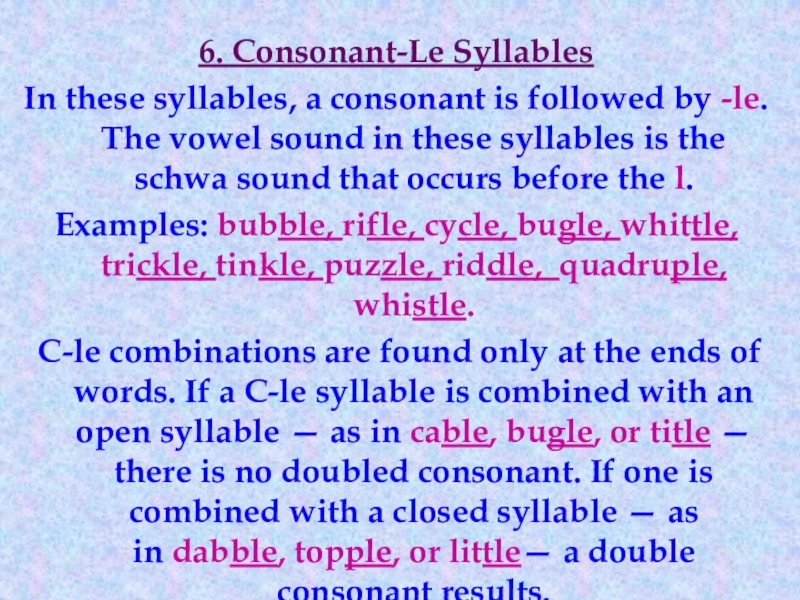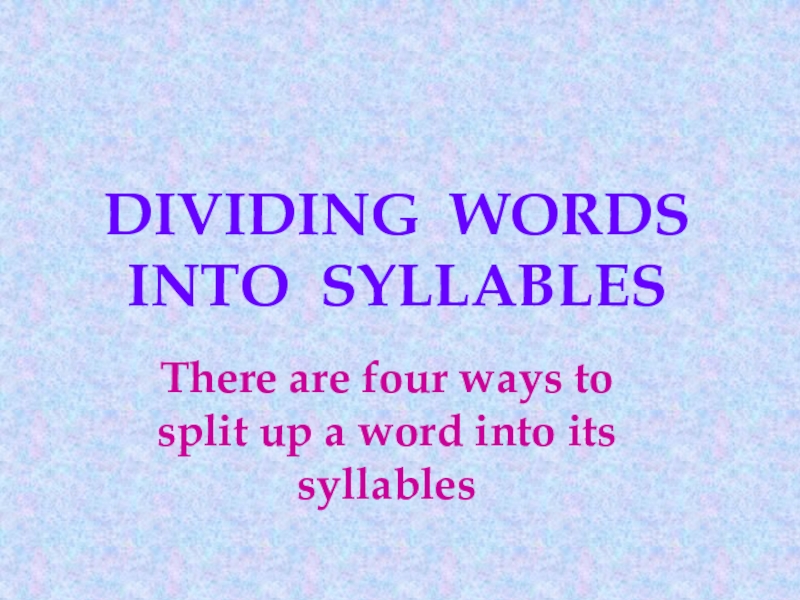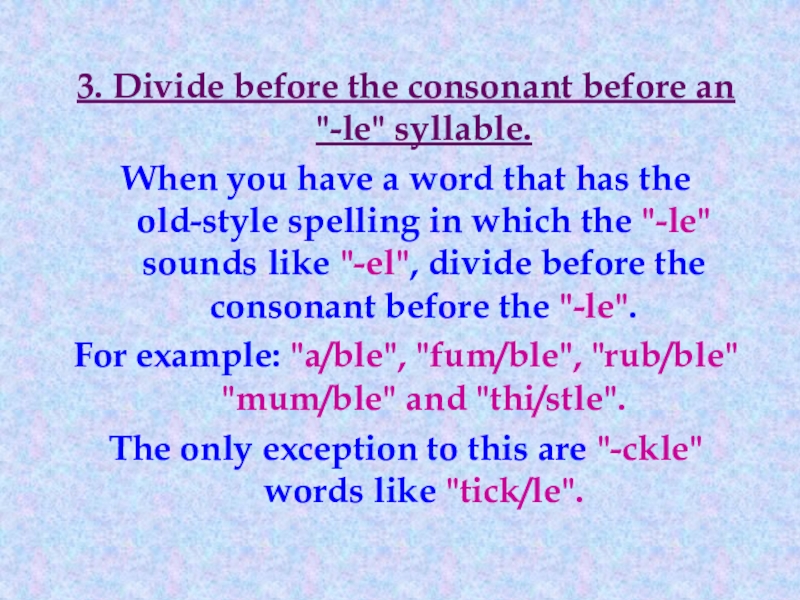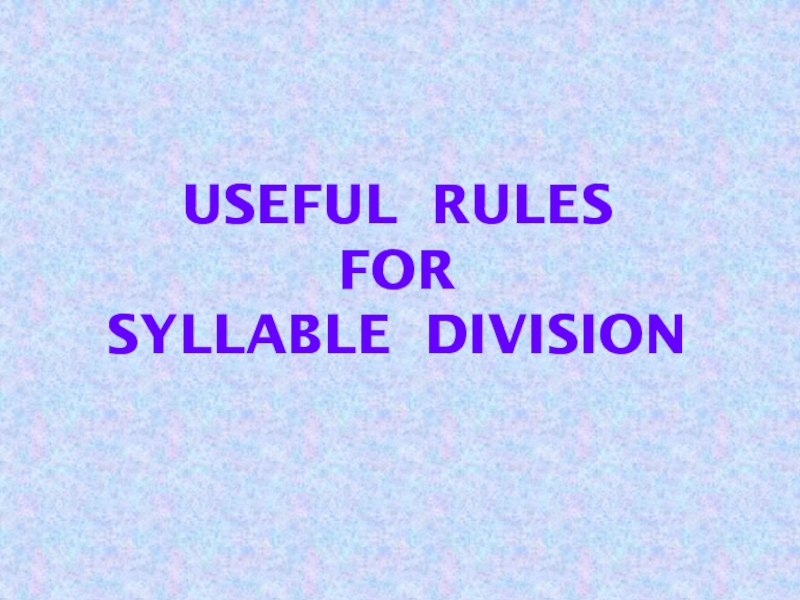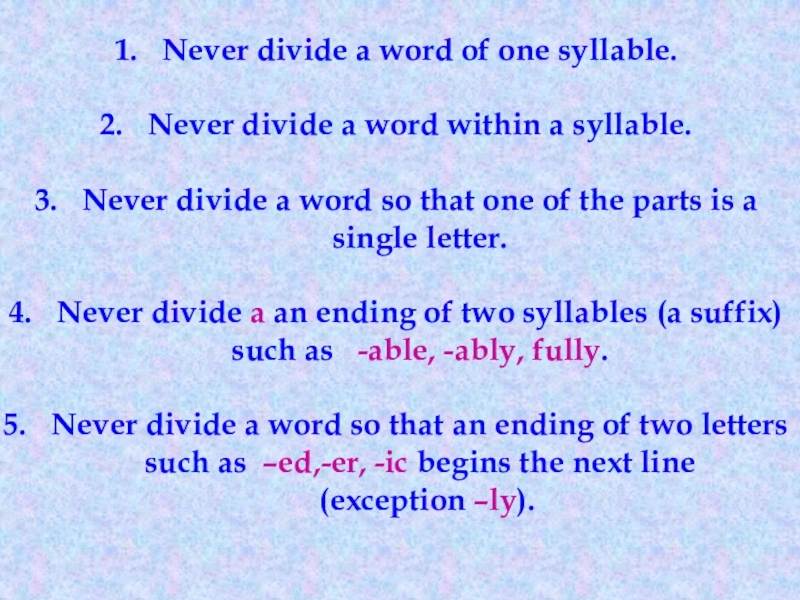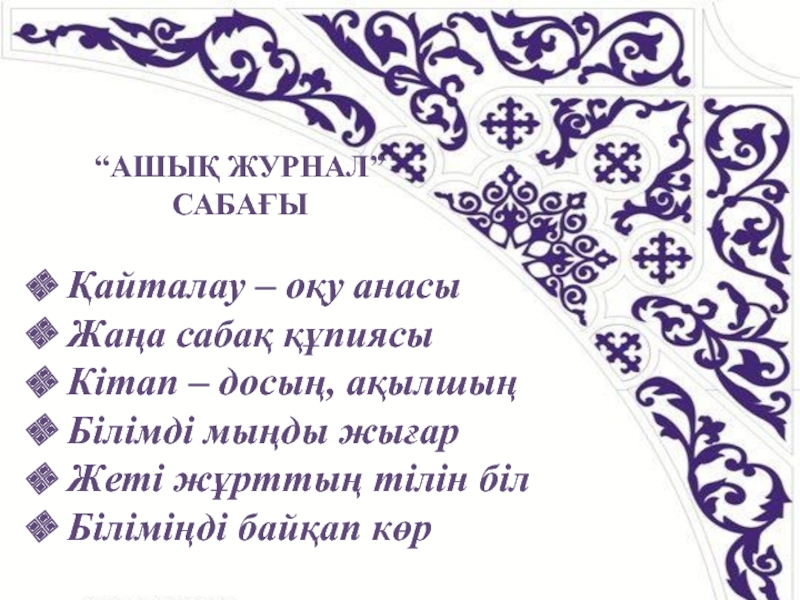- Главная
- Разное
- Образование
- Спорт
- Естествознание
- Природоведение
- Религиоведение
- Французский язык
- Черчение
- Английский язык
- Астрономия
- Алгебра
- Биология
- География
- Геометрия
- Детские презентации
- Информатика
- История
- Литература
- Математика
- Музыка
- МХК
- Немецкий язык
- ОБЖ
- Обществознание
- Окружающий мир
- Педагогика
- Русский язык
- Технология
- Физика
- Философия
- Химия
- Шаблоны, фоны, картинки для презентаций
- Экология
- Экономика
Презентация, доклад по теоретической фонетике на тему Types of syllables
Содержание
- 1. Презентация по теоретической фонетике на тему Types of syllables
- 2. A syllable is a basic unit of written and
- 3. Counting syllables
- 4. To find the number of syllables in
- 5. The number of syllables that you hear
- 6. Six kinds of syllables
- 7. Six written syllable-spelling conventions are used in
- 8. 1. Closed Syllables When the vowel of
- 9. 2. Open Syllables If a syllable is
- 10. 3. Silent-E Syllables A silent-e syllable ends
- 11. 4. Vowel Combination Syllables A vowel combination
- 12. 5. Vowel-R Syllables A vowel-r syllable is
- 13. 6. Consonant-Le Syllables In these syllables, a
- 14. Dividing words into syllablesThere are four ways to split up a word into its syllables
- 15. 1. Divide between two middle consonants.Split up
- 16. 2. Usually divide before a single middle
- 17. 3. Divide before the consonant before an
- 18. 4. Divide off any compound words, prefixes, suffixes and
- 19. Useful Rules for Syllable Division
- 20. Never divide a word of one syllable.Never
- 21. Thank you for attention
A syllable is a basic unit of written and spoken language. It is a unit consisting of uninterrupted sound that can be used to make up words. For example, the word hotel has two syllables: ho and tel. These will be marked here
Слайд 2A syllable is a basic unit of written and spoken language. It is
a unit consisting of uninterrupted sound that can be used to make up words.
For example, the word hotel has two syllables: ho and tel. These will be marked here as in ho/tel.
For example, the word hotel has two syllables: ho and tel. These will be marked here as in ho/tel.
Слайд 4To find the number of syllables in a word, use the
following steps:
1) Count the vowels in the word.
2) Subtract any silent vowels, (like the silent e at the end of a word, or the second vowel when two vowels are together in a syllable)
3) Subtract one vowel from every diphthong (diphthongs only count as one vowel sound.)
4) The number of vowels sounds left is the same as the number of syllables.
1) Count the vowels in the word.
2) Subtract any silent vowels, (like the silent e at the end of a word, or the second vowel when two vowels are together in a syllable)
3) Subtract one vowel from every diphthong (diphthongs only count as one vowel sound.)
4) The number of vowels sounds left is the same as the number of syllables.
Слайд 5The number of syllables that you hear when you pronounce a
word is the same as the number of vowels sounds heard. For example:
1) The word came has 2 vowels, but the e is silent, leaving one vowel sound and one syllable.
2) The word outside has 4 vowels, but the e is silent and the ou is a diphthong which counts as only one sound, so this word has only two vowel sounds and therefore, two syllables.
1) The word came has 2 vowels, but the e is silent, leaving one vowel sound and one syllable.
2) The word outside has 4 vowels, but the e is silent and the ou is a diphthong which counts as only one sound, so this word has only two vowel sounds and therefore, two syllables.
Слайд 7Six written syllable-spelling conventions are used in English spelling. These were
regularized by Samuel Webster to justify his 1806 dictionary's division of syllables. The conventions are useful to teach because they help students remember when to double letters in spelling and how to pronounce the vowels in new words. The conventions also help teachers organize decoding and spelling instruction. There are six different kinds of syllables in English.
Слайд 81. Closed Syllables
When the vowel of a syllable is short,
the syllable will be closed off by one or more consonants. Therefore, if a closed syllable is connected to another syllable that begins with a consonant, two consonant letters will come between the syllables (com-mon, but-ter).
Two or more consonant letters often follow short vowels in closed syllables (dodge, stretch, back, stuff, doll, mess, jazz, in, ask, truck, sock, stretch, twelfth, on). This is a spelling convention; the extra letters do not represent extra sounds. Each of these example words has only one consonant phoneme at the end of the word. The letters give the short vowel extra protection against the unwanted influence of vowel suffixes (backing; stuffed; messy).
Two or more consonant letters often follow short vowels in closed syllables (dodge, stretch, back, stuff, doll, mess, jazz, in, ask, truck, sock, stretch, twelfth, on). This is a spelling convention; the extra letters do not represent extra sounds. Each of these example words has only one consonant phoneme at the end of the word. The letters give the short vowel extra protection against the unwanted influence of vowel suffixes (backing; stuffed; messy).
Слайд 92. Open Syllables
If a syllable is open, it will end
with a long vowel sound spelled with one vowel letter; there will be no consonant to close it and protect the vowel (to-tal, ri-val, bi-ble, mo-tor). Therefore, when syllables are combined, there will be no doubled consonant between an open syllable and one that follows.
A few single-syllable words in English are also open syllables. They include me, she, he and no, so, go, I.
A few single-syllable words in English are also open syllables. They include me, she, he and no, so, go, I.
Слайд 103. Silent-E Syllables
A silent-e syllable ends in an e, has one
and only one consonant before that e, and has one and only one vowel before that consonant. Examples: ate, ice, tune, slope, strobe, these, wake, whale, while, yoke, yore, rude, hare.
Слайд 114. Vowel Combination Syllables
A vowel combination syllable has a cluster
of two or three vowels or a vowel-consonant unit with a sound or sounds particular to that unit.
Examples: rain, day, see, veil, pie, piece, noise, toy, cue, true, thief, boil, hay, suit, boat, and straw.
Examples: rain, day, see, veil, pie, piece, noise, toy, cue, true, thief, boil, hay, suit, boat, and straw.
Слайд 125. Vowel-R Syllables
A vowel-r syllable is one which includes one
and only one vowel followed by r, or one vowel followed by r which is followed by a silent e, or a vowel combination followed by r. Vowel-r syllables are numerous, variable, and difficult for students to master; they require continuous review. The /r/ phoneme is elusive for students whose phonological awareness is under-developed.
Examples: car, or, care, ire, air, deer, perform, ardor, mirror, further, worth, wart.
Examples: car, or, care, ire, air, deer, perform, ardor, mirror, further, worth, wart.
Слайд 136. Consonant-Le Syllables
In these syllables, a consonant is followed by -le.
The vowel sound in these syllables is the schwa sound that occurs before the l.
Examples: bubble, rifle, cycle, bugle, whittle, trickle, tinkle, puzzle, riddle, quadruple, whistle.
C-le combinations are found only at the ends of words. If a C-le syllable is combined with an open syllable — as in cable, bugle, or title — there is no doubled consonant. If one is combined with a closed syllable — as in dabble, topple, or little— a double consonant results.
Examples: bubble, rifle, cycle, bugle, whittle, trickle, tinkle, puzzle, riddle, quadruple, whistle.
C-le combinations are found only at the ends of words. If a C-le syllable is combined with an open syllable — as in cable, bugle, or title — there is no doubled consonant. If one is combined with a closed syllable — as in dabble, topple, or little— a double consonant results.
Слайд 151. Divide between two middle consonants.
Split up words that have two
middle consonants. For example:
hap/pen, bas/ket, let/ter, sup/per, din/ner, Den/nis.
The only exceptions are the consonant digraphs. Never split up consonant digraphs as they really represent only one sound. The exceptions are "th", "sh", "ph", "ch", "wh".
hap/pen, bas/ket, let/ter, sup/per, din/ner, Den/nis.
The only exceptions are the consonant digraphs. Never split up consonant digraphs as they really represent only one sound. The exceptions are "th", "sh", "ph", "ch", "wh".
Слайд 162. Usually divide before a single middle consonant.
When there is only
one syllable, you usually divide in front of it, as in:
"o/pen", "i/tem", "e/vil", and "re/port".
The only exceptions are those times when the first syllable has an obvious short sound, as in "cab/in".
"o/pen", "i/tem", "e/vil", and "re/port".
The only exceptions are those times when the first syllable has an obvious short sound, as in "cab/in".
Слайд 173. Divide before the consonant before an "-le" syllable.
When you have
a word that has the old-style spelling in which the "-le" sounds like "-el", divide before the consonant before the "-le".
For example: "a/ble", "fum/ble", "rub/ble" "mum/ble" and "thi/stle".
The only exception to this are "-ckle" words like "tick/le".
For example: "a/ble", "fum/ble", "rub/ble" "mum/ble" and "thi/stle".
The only exception to this are "-ckle" words like "tick/le".
Слайд 184. Divide off any compound words, prefixes, suffixes and roots which have vowel
sounds.
Split off the parts of compound words like "sports/car" and "house/boat".
Divide off prefixes such at "un/happy", "pre/paid", or "re/write".
Also divide off suffixes as in the words "farm/er", "teach/er", "hope/less" and "care/ful".
In the word "stop/ping", the suffix is actually "-ping" because this word follows the rule that when you add "-ing" to a word with one syllable, you double the last consonant and add the "-ing".
Split off the parts of compound words like "sports/car" and "house/boat".
Divide off prefixes such at "un/happy", "pre/paid", or "re/write".
Also divide off suffixes as in the words "farm/er", "teach/er", "hope/less" and "care/ful".
In the word "stop/ping", the suffix is actually "-ping" because this word follows the rule that when you add "-ing" to a word with one syllable, you double the last consonant and add the "-ing".
Слайд 20Never divide a word of one syllable.
Never divide a word within
a syllable.
Never divide a word so that one of the parts is a single letter.
Never divide a an ending of two syllables (a suffix) such as -able, -ably, fully.
Never divide a word so that an ending of two letters such as –ed,-er, -ic begins the next line
(exception –ly).
Never divide a word so that one of the parts is a single letter.
Never divide a an ending of two syllables (a suffix) such as -able, -ably, fully.
Never divide a word so that an ending of two letters such as –ed,-er, -ic begins the next line
(exception –ly).
